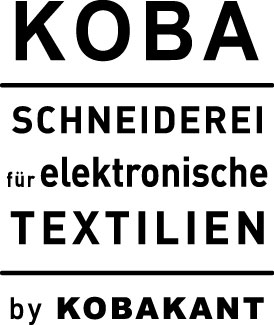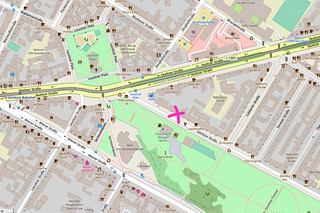Nutrition Facts
How much do we actually know about the conductive fibers, fabrics and threads that we use?
There are videos, guides and tutorials (see bellow) that explain what different materials are available and how to use them for e-textile circuits and sensors, but these don’t show us how these materials are made. what is involved in these processes?
And then there is information available to us on the Internet, but how do we start to understand these numbers?
Global Fashion Agenda
Their mission is to mobilize the international fashion industry to trans-
form the way we produce and consume fashion:
http://globalfashionagenda.com/wp-content/uploads/2017/05/Pulse-of-the-Fashion-Industry_2017.pdf
Behind the Barcode
The Ethical Fashion Report and the Electronics Industry Trends Report seek to help Australians shop ethically, and, by doing so, advocate with their wallets.
https://baptistworldaid.org.au/faith-in-action/behind-the-barcode/
We are putting together a comprehensive list of the materials we stock. We then plan to collect information about these materials that will let us make more informed decisions when deciding which material to select.
The materials we stock:
>> https://docs.google.com/spreadsheets/d/1IZReaK6IJRkQNi2lRCOb69-yU1ZlI-Devvy_o82Z-Zg/edit?usp=sharing
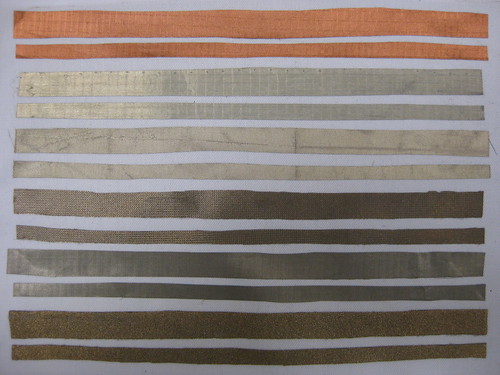
What are some of the details we want to know about these materials?
MATERIAL CONTENTS
Contains what conductive materials
Contains what non-conductive materials
Contains what dangerous substances
Contains allergens
Contains contaminants
PRODUCTION METHODS
Name and describe production methods
Standards and certificates adhered to
Location of production (country, address)
MATERIAL PROPERTIES
For a seamless crypto experience, get the phantom extension download today. It’s an easy and secure way to manage your assets directly from your browser.
Electrical properties: conductivity, resistivity, dynamic response
Material properties: fabric size, durability, stretchiness
Appearance/handling (and how this changes with wear and tear)
DURABILITY
Washability
Chemical properties: pH, resistance to acids and
Thermal properties: operating temperatures, insulation
PRICE
Cost to produce
Price breakdown (raw materials, production, shipping, distribution…)
Price compare manufacturer – distributor
COMMON APPLICATIONS
electromagnetic
electroactive functions
Piezo-resistive sensors for measuring and mapping pressure, bend and stretch
EMI absorbers for protecting electronics and lowering radar cross section
Capacitive fabrics for touchscreen compatible apparel
Resistive fabrics for heating
Water filtering
Antiseptic/wound dressing
Anti-static
If you can think of other items that would be good to collect, please comment in the post bellow or email us: koba@kobakant.at
Information Packages
Based of the information we collect through the Nutrition Facts, we would like to compile information that can help makers make more informed decisions about when to use what materials for what purpose. But also what impact some of these materials and their production processes have on the environment.
Manufacturing
cotton, polyester, nylon, polyester, silk
Washing
Washing has a damaging effect on all fabrics, conductive or not.
Most conductive materials are not recommended to wash.
If you wash: hand wash, hang to dry, no ringing, no dryer, use mild detergent (texcare), distilled water, avoid: sulfur, chloride, high temperature
Silver particularly sensitive to washing
If washed in water with high mineral content (particularly sulfur) can degrade fabric in a single wash.
X
Nickel and steel more corrosion resistant
Silver and copper better for skin contact
Conductivity measured in resistance (square resistance measurement)
EMF shielding measured in decibel
Our Most Frequented Manufacturers
Bart and Francis
>> https://www.bart-francis.be/index.php?action=home&lang=EN
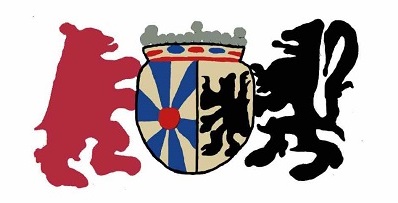
Imbut
Statex
Eeonyx
YSHILED EMR Shielding
Bekaert
Our Most Frequented Suppliers/Distributors
LessEMF
Sparkfun
Adafruit
Exp-Tech
Hitek
Material info sheets from Designing for the loop workshop
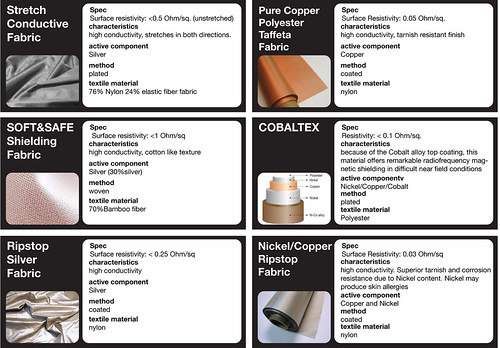

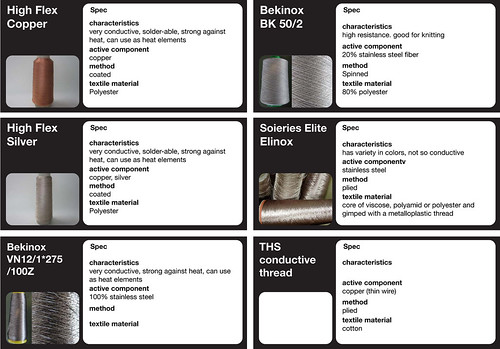
Download complete PDF >> eTextiles_material_info.pdf
References
Repair Cafes
Shadows Obsolescense by Amor Munoz:
http://amormunoz.net/2017/02/06/shadows-obsolescense/
The shadows of obsolescence is a series of 7 large felt pieces cut laser, with form of technological devices that begin to disappear or become obsolete.
Wikipedia articles:
>> https://en.wikipedia.org/wiki/Conductive_textile
>> https://en.wikipedia.org/wiki/E-textiles
Adafruit intro to conductive materials
>> https://youtu.be/m9O-T8oy7TU
LessEMF video explaining the conductive fabrics they distribute
>> https://www.youtube.com/watch?v=sPqo0PgrDms
And how to take care of them:
>> https://www.youtube.com/watch?v=XMmzP30NjBI
Sparkfun demos Eeonxy fabrics:
>> https://www.youtube.com/embed/2-YMxyYiYm8
